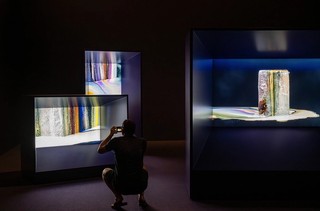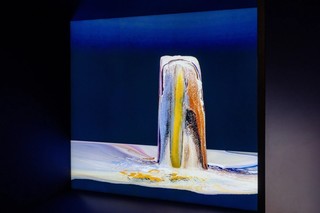Melting pigment-infused block of ice creates a hypnotic effect

Dawn Ng, Singapore b.1982 / ‘The Earth is an hourglass’, comprising: The Earth is an hourglass 2024 / Single-channel 4K video: 16:9, colour, 38:33 minutes / Purchased 2024 with funds from the Melbourne Art Foundation and the QAGOMA Foundation / Collection: Queensland Art Gallery | Gallery of Modern Art / © Dawn Ng / Orbit I 2024 and Orbit II 2024 / Two-channel 4K video: 16:9, colour, 38:33 minutes / Installed for ‘The 11th Asia Pacific Triennial of Contemporary Art’ / Courtesy: The artist and Sullivan+Strumpf, Singapore / View full image
Dawn Ng’s work across a wide range of contemporary media is unified by subtle gradations of colour, which function as a way of exploring the passage and experience of time. Since 2018, the artist has documented the disintegration of frozen blocks of coloured pigment.
The blocks, each weighing around 60 kilograms, undergo a three-week freezing process as Ng builds layers of strikingly coloured dyes and watercolour pigment within them. When finished, the blocks are photographed from multiple angles, and allowed to melt, with the pigment captured on paper to produce paintings. Timelapse videos compress the entire 20-hour process of decomposition into a mesmerising 40 minutes.
Watch | Dawn Ng introduces ‘The Earth is an hourglass’
With its multiple screens and field of colour, ‘The Earth is an hourglass’ installation for the eleventh Asia Pacific Triennial expands the hypnotic effect of these videos into an enveloping visual experience. The various screens are presented in deliberately monolithic frames suggestive of sculptural heft and pictorial depth, staggered through the space to encourage movement through a field of colour and movement.
Five videos play simultaneously: one taking in the whole, the others focusing on specific details. The work’s black ground and palette of oceanic azure and telluric rust are inspired by photographs of Earth taken from space, introducing cosmic and metaphorical associations of a shared place, and of time running out.

Dawn Ng, Singapore b.1982 / ‘The Earth is an hourglass’, comprising: The Earth is an hourglass 2024 / Single-channel 4K video: 16:9, colour, 38:33 minutes / Purchased 2024 with funds from the Melbourne Art Foundation and the QAGOMA Foundation / Collection: Queensland Art Gallery | Gallery of Modern Art / © Dawn Ng / Orbit I 2024 and Orbit II 2024 / Two-channel 4K video: 16:9, colour, 38:33 minutes / Installed for ‘The 11th Asia Pacific Triennial of Contemporary Art’ / Courtesy: The artist and Sullivan+Strumpf, Singapore / Photograph: C Callistemon © QAGOMA / View full image

Dawn Ng, Singapore b.1982 / ‘The Earth is an hourglass’, comprising: The Earth is an hourglass 2024 / Single-channel 4K video: 16:9, colour, 38:33 minutes / Purchased 2024 with funds from the Melbourne Art Foundation and the QAGOMA Foundation / Collection: Queensland Art Gallery | Gallery of Modern Art / © Dawn Ng / Orbit I 2024 and Orbit II 2024 / Two-channel 4K video: 16:9, colour, 38:33 minutes / Installed for ‘The 11th Asia Pacific Triennial of Contemporary Art’ / Courtesy: The artist and Sullivan+Strumpf, Singapore / Photograph: J Ruckli © QAGOMA / View full image
Edited extract from the publication The 11th Asia Pacific Triennial of Contemporary Art, QAGOMA, 2024
Asia Pacific Triennial
30 November 2024 – 27 April 2025
Queensland Art Gallery and Gallery of Modern Art (QAGOMA)
Brisbane, Australia
Free entry

